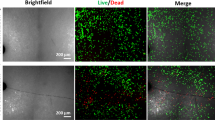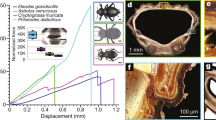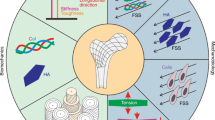Abstract
Despite centuries of work, dating back to Galileo1, the molecular basis of bone's toughness and strength remains largely a mystery. A great deal is known about bone microsctructure2,3,4,5 and the microcracks6,7 that are precursors to its fracture, but little is known about the basic mechanism for dissipating the energy of an impact to keep the bone from fracturing. Bone is a nanocomposite of hydroxyapatite crystals and an organic matrix. Because rigid crystals such as the hydroxyapatite crystals cannot dissipate much energy, the organic matrix, which is mainly collagen, must be involved. A reduction in the number of collagen cross links has been associated with reduced bone strength8,9,10 and collagen is molecularly elongated (‘pulled’) when bovine tendon is strained11. Using an atomic force microscope12,13,14,15,16, a molecular mechanistic origin for the remarkable toughness of another biocomposite material, abalone nacre, has been found12. Here we report that bone, like abalone nacre, contains polymers with ‘sacrificial bonds’ that both protect the polymer backbone and dissipate energy. The time needed for these sacrificial bonds to reform after pulling correlates with the time needed for bone to recover its toughness as measured by atomic force microscope indentation testing. We suggest that the sacrificial bonds found within or between collagen molecules may be partially responsible for the toughness of bone.
This is a preview of subscription content, access via your institution
Access options
Subscribe to this journal
Receive 51 print issues and online access
$199.00 per year
only $3.90 per issue
Buy this article
- Purchase on Springer Link
- Instant access to full article PDF
Prices may be subject to local taxes which are calculated during checkout



Similar content being viewed by others
References
Ascenzi, A. Biomechanics and Galileo Galilei. J. Biomech. 26, 95–100 (1993).
Weiner, S. & Wagner, H. D. The material bone: structure-mechanical function relations. Annu. Rev. Mater. Sci. 28, 271–298 (1998).
Weiner, S., Traub, W. & Wagner, H. D. Lamellar bone: structure-function relations. J. Struct. Biol. 126, 241–255 (1999).
An, Y. H. & Draughn, R. A. Mechanical Testing of Bone and the Bone–Implant Interface (CRC Press, New York, 2000).
Currey, J. D. The Mechanical Adaptations of Bones (Princeton Univ. Press, Princeton, 1984).
Reilly, G. C. & Currey, J. D. The effects of damage and microcracking on the impact strength of bone. J. Biomech. 33, 337–343 (2000).
Reilly, G. C. & Currey, J. D. The development of microcracking and failure in bone depends on the loading mode to which it is adapted. J. Exp. Biol. 202, 543–552 (1999).
Oxlund, H., Barckman, M., Ortoft, G. & Andreassen, T. T. Reduced concentrations of collagen cross-links are associated with reduced strength of bone. Bone 17, S365–S371 (1995).
Burstein, A. H., Zika, J. M., Heiple, K. G. & Klein, L. Contribution of collagen and mineral to the elastic–plastic properties of bone. J. Bone Joint Surg. A 57, 956–961 (1975).
Knott, L. & Bailey, A J. Collagen cross-links in mineralizing tissues: A review of their chemistry, function, and clinical relevance. Bone 22, 181–187 (1998).
Sasaki, N. & Odajima, S. Elongation mechanism of collagen fibrils and force–strain relations of tendon at each level of structural hierarchy. J. Biomech. 29, 1131–1136 (1996).
Smith, B. L. et al. Molecular mechanistic origin of toughness of natural adhesives, fibre and composites. Nature 399, 761–763 (1999).
Rief, M., Gautel, M., Oesterhelt, F., Fernandez, J. M. & Gaub, H. E. Reversible unfolding of individual titin immunoglobulin domains by AFM. Science 276, 1109–1112 (1997).
Rief, M., Gautel, M., Schemmel, A. & Gaub, H. E. The mechanical stability of immunoglobulin and fibronectin II domains in the muscle protein titin measured by atomic force microscopy. Biophys. J. 75, 3008–3014 (1998).
Li, H., Oberhauser, A. F., Fowler, S. B., Clarke, J. & Fernandez, J. M. Atomic force microscopy reveals the mechanical design of a modular protein. Proc. Natl Acad. Sci. USA 97, 6527–6531 (2000).
Oberhauser, A. F., Hansma, P. K., Carrion-Vazquez, M. & Fernandez, J. M. Stepwise unfolding of titin under force-clamp atomic force microscopy. Proc. Natl Acad. Sci. USA 98, 468–472 (2001).
Bustamante, C., Marko, J. F., Siggia, E. D. & Smith, S. Entropic elasticity of lambda-phage DNA. Science 265, 1599–1600 (1994).
Chernoff, E. A. G. & Chernoff, D. A. Atomic force microscope images of collagen fibers. J. Vac. Sci. Technol. A 10, 596–599 (1994).
Revenko, I., Sommer, F., Minh, D. T., Garrone, R. & Franc, J. M. Atomic force microscopy study of the collagen fiber structure. Biol. Cell 80, 67–69 (1994).
Bigi, A., Gandolfi, M., Roveri, N. & Valdre, G. In vitro calcified tendon collagen: an atomic force and scanning electron microscopy investigation. Biomaterials 18, 657–665 (1997).
El Feninat, F., Ellis, T. H., Sacher, E. & Stangel, I. Moisture-dependent renaturation of collagen in phosphoric acid etched human dentin. J. Biomed. Mater. Res. 42, 549–553 (1998).
Miyagawa, A. et al. Surface topology of collagen fibrils associated with proteoglycans in mouse cornea and sclera. Jpn J. Ophthalmol. 44, 591–595 (2000).
Fullwood, N. J., Hammiche, A., Pollock, H. M., Hourston, D. J. & Song, M. Atomic force microscopy of the cornea and sclera. Curr. Eye Res. 14, 529–535 (1995).
Paige, M. F. & Goh, M. C. Ultrastructure and assembly of segmental long spacing collagen studied by atomic force microscopy. Micron 32, 355–361 (2001).
Lin, H., Clegg, D. O. & Lal, R. Imaging real-time proteolysis of single collagen I molecules with an atomic force microscope. Biochemistry 38, 9956–9963 (1999).
Yamamoto, S. et al. The subfibrillar arrangement of corneal and scleral collagen fibrils as revealed by scanning electron and atomic force microscopy. Arch. Histol. Cytol. 63, 127–135 (2000).
Dufrene, Y. F., Marchal, T. G. & Rouxhet, P. G. Influence of substratum surface properties of the organization of adsorbed collagen films: in situ characterization by atomic force microscopy. Langmuir 15, 2871–2878 (1999).
Charras, G. T., Lehenkari, P. P. & Horton, M. A. Atomic force microscopy can be used to mechanically stimulate osteoblasts and evaluate cellular strain distributions. Ultramicroscopy 86, 86–95 (2001).
Einbinder, J. & Schubert, M. Binding of mucopolysaccharides and dyes by collagen. J. Biol. Chem. 188, 335–341 (1951).
Greene, E. C. Anatomy of the Rat (Hafner, New York, 1963).
Acknowledgements
We thank E. Oroudjev, J. Cooper, D. Kohn and L. Fisher for their assistance and discussion. We also thank the reviewers of our paper for their helpful suggestions. We thank S. Babbitt and the American Philosophical Society for granting us permission to use the drawing of a rat femur30 shown in Figs 2 and 3. This work was supported by the Materials Research Division and MCB Division of the National Science Foundation, the Materials Research Laboratory Program of the National Science Foundation, and the MURI programme of the Army Research Office.
Author information
Authors and Affiliations
Corresponding author
Rights and permissions
About this article
Cite this article
Thompson, J., Kindt, J., Drake, B. et al. Bone indentation recovery time correlates with bond reforming time. Nature 414, 773–776 (2001). https://doi.org/10.1038/414773a
Received:
Accepted:
Issue Date:
DOI: https://doi.org/10.1038/414773a
This article is cited by
-
Hyperbranched polymer functionalized flexible perovskite solar cells with mechanical robustness and reduced lead leakage
Nature Communications (2023)
-
Force transmission by retrograde actin flow-induced dynamic molecular stretching of Talin
Nature Communications (2023)
-
Macroscale double networks: highly dissipative soft composites
Polymer Journal (2022)
-
An experimentally informed statistical elasto-plastic mineralised collagen fibre model at the micrometre and nanometre lengthscale
Scientific Reports (2021)
-
Full strength and toughness recovery after repeated cracking and healing in bone-like high temperature ceramics
Scientific Reports (2020)
Comments
By submitting a comment you agree to abide by our Terms and Community Guidelines. If you find something abusive or that does not comply with our terms or guidelines please flag it as inappropriate.



